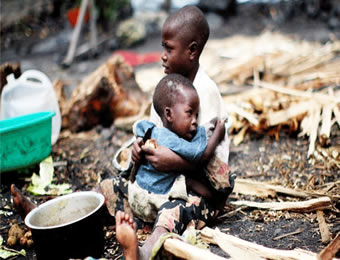A new, interactive digital report launched on Tuesday shows that the number of hungry people in Africa continues to rise, spurred by conflict, climate change and economic slowdowns including those triggered by COVID-19.
The African Union Commission (AUC), the Food and Agriculture Organisation of the United Nations (FAO), and United Nations Economic Commission for Africa (UNECA) launched the digital report as the latest update to their annual reporting on the state of food security and nutrition in Africa.
According to a statement by UNECA, hunger on the continent has worsened substantially since 2013, the report states, and most of this deterioration occurred between 2019 and 2020. The situation is expected to have deteriorated further this year, with no easing of hunger’s main drivers.
The three agencies behind the report are calling on African countries to heed the call for agrifood systems transformation.
“Countries must engage in and leverage the outcomes of the United Nations Food Systems Summit, the Nutrition for Growth Summit and the 2021 United Nations Climate Change Conference (COP26),” FAO Assistant Director-General and Regional Representative for Africa Abebe Haile-Gabriel said with William Lugemwa, UNECA’s Director of the Private Sector Development and Finance Division, and Josefa Sacko, African Union Commissioner for Agriculture, Rural Development, Blue Economy and Sustainable Environment, in the report’s joint foreword.
“A common vision, strong political leadership and effective cross-sectoral collaboration, which includes the private sector, are essential to agree on trade-offs and to identify and implement sustainable solutions that transform agrifood systems,” they said in Africa Regional Overview of Food Security and Nutrition 2021: Statistics and Trends.
The digital report allows readers to get a better understanding of the scope of hunger in Africa. In 2020, 281.6 million Africans were undernourished, an increase of 89.1 million over 2014, the report shows. There is significant variation in the levels and trends of hunger across the subregions. About 44 percent of undernourished people on the continent live in Eastern Africa, 27 percent in Western Africa, 20 percent in Central Africa, 6.2 percent in Northern Africa, and 2.4 percent in Southern Africa.
Short term measures to address the hunger challenge include countries providing humanitarian assistance and effective social protection measures, the report says. Over the longer term, countries will need to invest in agriculture and related sectors, as well as in water, health, and education services.
YOU SHOULD NOT MISS THESE HEADLINES FROM NIGERIAN TRIBUNE
We Have Not Had Water Supply In Months ― Abeokuta Residents
In spite of the huge investment in the water sector by the government and international organisations, water scarcity has grown to become a perennial nightmare for residents of Abeokuta, the Ogun State capital. This report x-rays the lives and experiences of residents in getting clean, potable and affordable water amidst the surge of COVID-19 cases in the state.
conflict fuelling Africa’s hunger crisis | conflict fuelling Africa’s hunger crisis |
WATCH TOP VIDEOS FROM NIGERIAN TRIBUNE TV
- Let’s Talk About SELF-AWARENESS
- Is Your Confidence Mistaken for Pride? Let’s talk about it
- Is Etiquette About Perfection…Or Just Not Being Rude?
- Top Psychologist Reveal 3 Signs You’re Struggling With Imposter Syndrome
- Do You Pick Up Work-Related Calls at Midnight or Never? Let’s Talk About Boundaries






